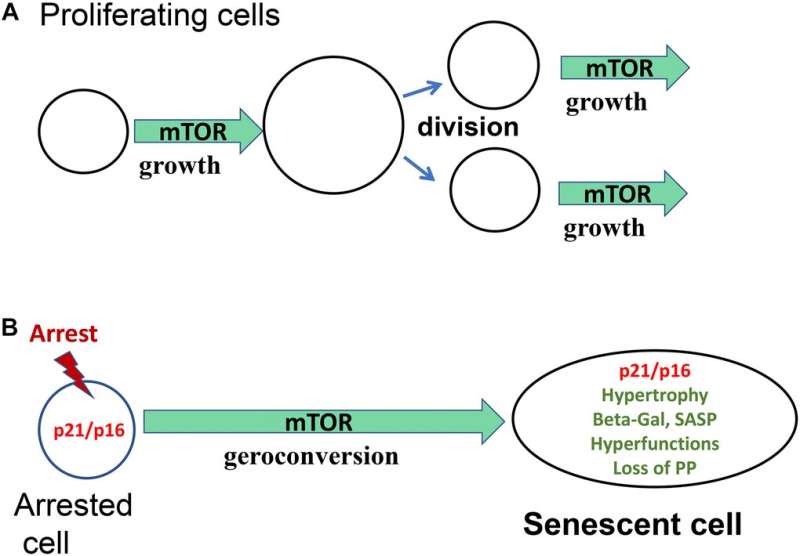Geroconversion as a form of growth. (A) Proliferating cells. Cellular enlargement (growth) is followed by cell division. mTOR is shown as one of the drivers of growth. (B) Arrested cells. In the arrest cell (p21 and p16) cellular enlargement is followed by cell division. mTOR is shown as one of the drivers of geroconversion. Credit: Aging (2023). DOI: 10.18632/aging.204543
A new review paper titled "Cellular senescence: when growth stimulation meets cell cycle arrest" has been published in Aging.
In this review, researcher Mikhail V. Blagosklonny, M.D., Ph.D., from Roswell Park Comprehensive Cancer Center, discusses cellular senescence—a natural process that occurs as cells age and eventually stop dividing. Recent research has revealed that cellular senescence can also be triggered by hypertrophy and hyperfunctions.
"At the very moment of cell-cycle arrest, the cell is not senescent yet. For several days in cell culture, the arrested cell is acquiring a senescent phenotype. What is happening during this geroconversion? Cellular enlargement (hypertrophy) and hyperfunctions (lysosomal and hyper-secretory) are hallmarks of geroconversion," writes Dr. Blagosklonny.
In his comprehensive review paper, Dr. Blagosklonny explores the complex relationship between growth stimulation and cell cycle arrest in cellular senescence. He discusses the various mechanisms that can lead to senescence, markers of senescence and geroconversion, and the importance of understanding these mechanisms and markers for the development of anti-aging drugs.
"The same pathways that drive geroconversion are involved in organismal aging and age-related diseases. The same drugs that slow down geroconversion also extend lifespan, as tested in animals so far. Targets of gerostatics (e.g., mTOR, PI3K) are involved in aging of animals from worms to mammals. Therefore, gerostatics are anti-aging drugs. The model of geroconversion is useful to discover anti-aging drugs," he concludes.
More information: Mikhail V. Blagosklonny, Cellular senescence: when growth stimulation meets cell cycle arrest, Aging (2023). DOI: 10.18632/aging.204543
Provided by Impact Journals LLC























